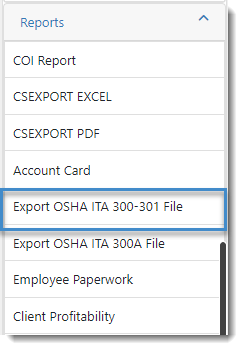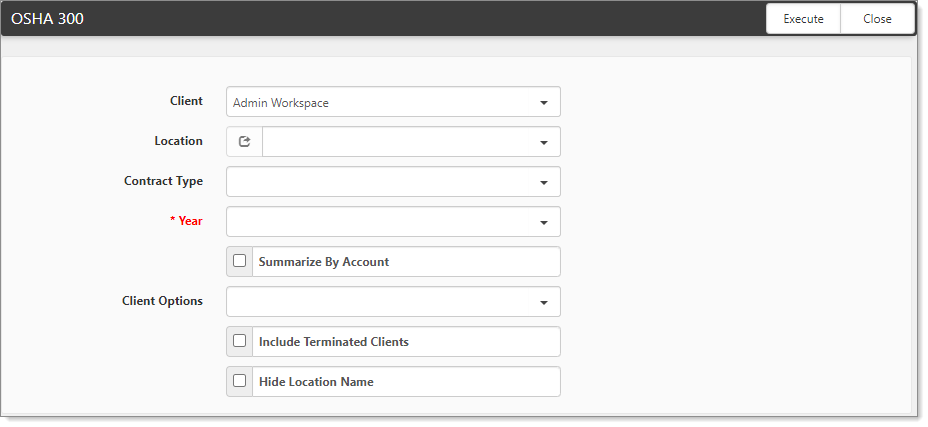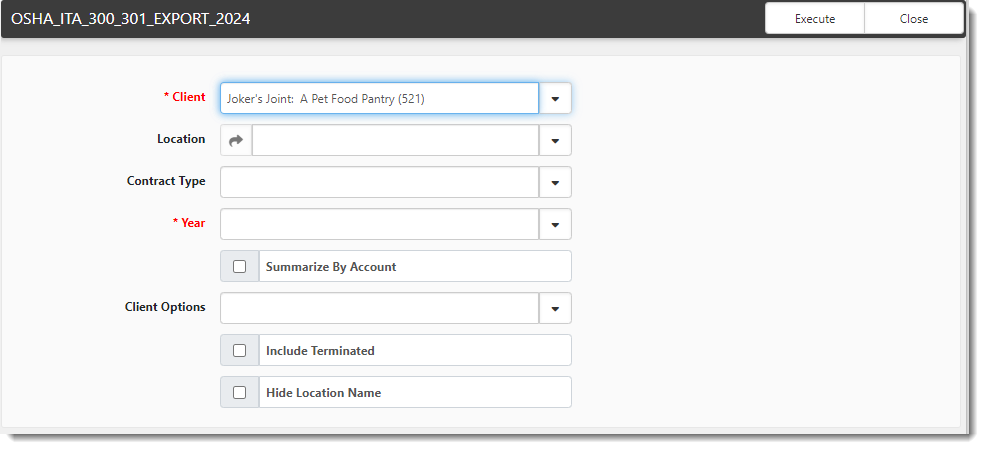OSHA 300 Report Details
The OSHA 300 report is a log of work-related injuries and illnesses logged throughout the calendar year. It includes confidential information, a description of the injury or illness, and the number of days away, restricted, or transferred. To produce OSHA logs from ClientSpace, the following areas must have accurate data:
-
WC Claims
-
RTW Records
-
Locations
The OSHA Log reports (300, 300A) previously included inactive locations in the report. Because some clients have a business need for inactive locations and there is no way to delete these locations through the user interface, the Client Location form has an Obsolete Date field. The OSHA 300/300A logic includes active Client Location records and inactive Client Location records where the Obsolete Date is within the OSHA Year selected. Inactive records that do not have an Obsolete Date are excluded.
Also see the Learning How: OSHA 300 Overview video at the end of this topic.
Note: As of Jan. 1, 2024, OSHA requires report submission through their Information Technology Application (ITA) portal. You can generate a merge report from ClientSpace for ITA portal submission. ITA requires a .CSV file format. The merge generates a combined OSHA 300/301 report in .xslx format. You can save the Excel file in the required .csv format prior to submission. To generate an OSHA 300/301 report for ITA submission, refer to the Generating an OSHA 300/301 ITA Export File section of this article.
To configure and run the report:
-
On the modules bar, select Admin Workspace.
The Admin Workspace tiles display.
- In the Action Center, under Reports, click OSHA 300.
The OSHA 300 form opens.
- Complete the form:
|
Client |
|
|
Location |
Location provides a list of Active Locations in that Workspace. This field is not appropriate for use when running from the Admin Workspace.
When Summarize By Account is not selected and the location is not populated, a report is generated for every client location, including active Client Location records and inactive Client Location records where the Obsolete Date (field on the Client Location) is within the OSHA Year selected. Inactive records that do not have an Obsolete Date are excluded. The claim is shown on the OSHA 300 report based on the Comp Claimant Location field matching the selected location. |
|
Contract Type |
Primarily used when running the report from the Admin Workspace for multiple clients. You can filter for Client Workspaces of the selected contract type. |
|
Year |
This required field filters for Claims logged in the selected calendar year. |
|
Summarize By Account |
When this option is selected, all available claims for the OSHA year selected display under the Primary location for that client. Also, if the Summarize By Account field is checked, only the Organization Name is used in the Establishment Name. The location is excluded. |
|
Client Options |
Used when running for multiple clients from the Admin Workspace. Select for clients With Claims, Without Claims, With and Without Claims. |
|
Include Terminated Clients |
Primarily used from the Admin Workspace. This setting allows you to include claims from workspaces where the client may have had claims and been terminated in the OSHA year selected. |
|
Hide Location Name |
If the Hide Location Name field is checked, only the Organization Name is used in the Establishment Name. The location is excluded. |
- Click Execute.
The report generates a PDF that you can open from your Downloads folder.
Column Mappings
The following table provides a mapping of the OSHA 300 report.
|
Column mappings |
Description |
|---|---|
|
Establishment Name |
The Establishment Name is derived by combining the Organization Name (Org.Name) and Location Name (ClientLocation.LocationName) fields. EX: Shelly's Seashells/FL. Note: If the Summarize By Account or Hide Location Name fields are checked, only the Organization Name is used. |
|
City, State |
City and State |
|
(A) Case No. |
The Case No. is filled in with the OSHA Case Number (CompClaim.CaseNumber)field on the Comp Claim form.
Note: This number resets to 1 each year based on the date of injury for the client. |
|
(B) Employee's Name |
If Privacy Consideration (CompClaim.IsPrivacyConsideration) is selected on the Comp Claim form, "Private" is displayed in the field. Otherwise, the Employee's first and last name are displayed. |
|
(C) Job Title |
Job Title fills in with the value from the Employment record Job Title (EmployeeEmploymentInformation.JobTitle) field where the Current Record checkbox is checked. |
|
(D)Date of Injury or Onset of Illness (Mo/Day) |
This fills in with the value from the Comp Claim form Date of Injury (CompClaim.DateOfInjury) field. |
|
(E) Where the Event Occurred |
This fills in with the value from the Accident Location (CompClaimInjury.AccidentSite) field located on the Comp Claim Injury tab. |
|
(F) Describe injury or illness |
This fills in with the value from the Accident Detail (InjuryAccidentDetails.CompClaimInjury) field located on the Comp Claim Injury tab. |
|
(G) Death |
This field is checked if the Resulted in Death (CompClaim.Resulted In Death) field located on the Comp Claim form is set to Yes. |
|
(H) Days away from work |
This field is checked if not a Death AND an Return to Work (RTW) History record exists for Out Of Work. Days away from work is based on Return To Work records that have a status of Out of Work. |
|
(I) Job transfer or restriction |
This field is checked if not a Death AND there are no Out of Work RTW records AND am RTW record exists for Light Duty. |
|
(J) Other recordable cases |
This field is checked if not a Death AND there are No Out of Work or Light Duty records AND an RTW record exists for either Full Duty or Alternate Job. |
|
(K) Away from work (days) |
Based on an RTW record of Out of Work. Not affected by Alternate Job or Full Duty. If an RTW record has no End Date, then End Date is assumed to be 12/31 of the OSHA Year. If the value is greater than 180 days, it defaults to 180 days. |
|
(L) On job transfer or restriction (days) |
Based on an RTW record of Out of Work. Not affected by Alternate Job or Full Duty. If an RTW record has no End Date, then End Date is assumed to be 12/31 of the OSHA Year. If the value is greater than 180 days, it defaults to 180 days. Job Transfer or Restrictions is based on RTW records that have a status of Light Duty. Intentionally, excludes Alternate Job. |
|
(M) (1) Injury, (2) Skin Disorder, (3) Respiratory Condition, (4) Poisoning, (5) Hearing Loss, (6) All other illnesses |
This fills in with the value from the OSHA Classification (luOSHAClassification.CompClaimInjury) field located on the Comp Claim Injury tab. |
The Location dataform fields, Related to Another Location? and Related Location, relate locations for OSHA. Totals for the related location are added when running the report. Run the reports for the sub-location when you manually select the location.
Generating an OSHA 300/301 ITA Export File
An Excel Merge named OSHA_ITA_300_301_EXPORT_2024 (System Admin![]() > Outputs > Merges) is used to generate a combined OSHA 300/301 report in the required format for OSHA ITA portal submission. You can manually generate the report from the Client Master record of the desired workspace using the steps outlined in this section.
> Outputs > Merges) is used to generate a combined OSHA 300/301 report in the required format for OSHA ITA portal submission. You can manually generate the report from the Client Master record of the desired workspace using the steps outlined in this section.
Note: When the yearly scheduled process Generate OSHA Forms runs the merge, the merge file is added as file attachment to the OSHA Forms dataform OSHA 300/301 ITA field. When you manually run the report, the file is deposited in your Windows Downloads folder.
To generate an OSHA 300/301 ITA Export File:
-
On the modules bar, select Clients, locate the desired Client Master record on the Client Master dashboard and then open it (or from a workspace landing page, click
 (Open) at the top of the Client Info widget.)
(Open) at the top of the Client Info widget.) -
In the Action Center, under Reports, click Export OSHA ITA 300-301 File.

The OSHA_ITA_300_301_EXPORT_2024 form opens.
-
Complete the form:
Client
This runs the export for the selected Workspace.
Location
Location provides a list of Active Locations in the Workspace.
Contract Type
Contract Type is a filter used to run the report for selected contract type. This setting was used with the orginal version of the OSHA 300 report where you can run the report from the Admin Workspace for multiple clients at once. This does not apply for the combined OSHA 300/301 merge export as you can only run the report for a specific workstation from the Client Master file of that workstation. You cannot run the report across multiple clients.
Year
This required field filters for Claims logged in the selected calendar year.
Summarize By Account
When this option is selected, all available claims for the OSHA year selected display under the Primary location for that client.
Client Options
This filter option is a carryover from the orginal version of the OSHA 300 report where you can run the report from the Admin Workspace for multiple clients at once and specify whether you want to include clients with claims, without claims or clients with and without claims (i.e., all clients). This does not apply for the combined OSHA 300/301 merge export as you can only run the report for a specific workstation from the Client Master file of that workstation. You cannot run the report across multiple clients.
Include Terminated Clients
This filter option is a carryover from thorginal version of the OSHA 300 report where you can run the report from the Admin Workspace for multiple clients at once and specify whether you want to include claims from clients across workspaces that have been terminated in the OSHA year selected. This does not apply for the combined OSHA 300/301 merge export as you can only run the report for a specific workstation from the Client Master file of that workstation. You cannot run the report across multiple clients.
Hide Location Name
If the Hide Location Name field is checked, only the Organization Name is used in the Establishment Name. The location is excluded.
-
Click Execute.
-
Retrieve the file from your Windows Downloads folder.
-
Save the file as a .CSV file prior to submitting through the ITA portal.
Learning How: OSHA 300 Overview
Watch the video OSHA 300 Overview.

